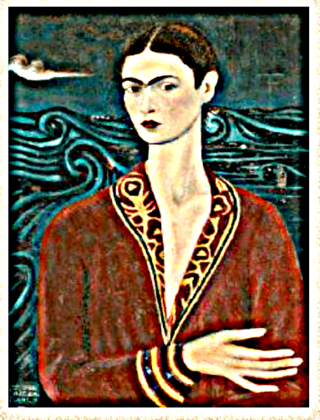Shane Eric Mathias's Blog, page 7
September 7, 2015
YOU HAVE A STORY TO TELL. HOW AND WHY TO WRITE IT
 It is the rare individual indeed who has reached adulthood and not experienced something traumatic, inspiring, humbling, or life-affirming. And yet, the vast majority of these powerful stories are never told. Many are the people who might find solace in the words of someone who can see the world through their lens.
It is the rare individual indeed who has reached adulthood and not experienced something traumatic, inspiring, humbling, or life-affirming. And yet, the vast majority of these powerful stories are never told. Many are the people who might find solace in the words of someone who can see the world through their lens.
We live in an age where information is everywhere. We are perhaps the most well informed society in history. But have we become wiser and more empathetic as a result? Perhaps not. Which is more important. information or self knowledge?
The breadth of human experience is limitless and within that universal spectrum of possibilities are incredible stories of achievement, tragedy, love, loss, success and abject poverty that deserve to be told. So many of you search for a purpose, a reason to exist. You search your soul for what you might have to offer your fellow man or woman, assuming it will be some as yet unrealized talent or skill. Yet you overlook what is right under your nose, the story of the very life you have lived or are now living. And it silently begs to be revealed.
 Perhaps helping others is not currently on your agenda. You���ve reached a dead end, the path ahead seems dark and foreboding. Maybe you lack confidence, you���re not good with people, you have a disability or something about your appearance that causes you to avoid human contact.
Perhaps helping others is not currently on your agenda. You���ve reached a dead end, the path ahead seems dark and foreboding. Maybe you lack confidence, you���re not good with people, you have a disability or something about your appearance that causes you to avoid human contact.
You feel stuck and wrack your brain for a way out of this conundrum, but come up empty. What���s the solution? Write!
Are you the one who was on top of the world? Maybe you had the best job, the greatest lover, the most loving family and everything you touched seemed to turn to gold and then one day, it was all taken away. A terrible accident; your partner left or died suddenly; a natural disaster or insurgent uprising tore your family apart and loved ones were lost forever; your world was rocked by a frightening diagnosis; you made a terrible mistake and lost your job, or you became collateral damage in the ebb and flow of capricious economic cycles. How can you recover? How can reassembling the rubble of your past lead to finding a meaningful way forward? Write!
 It seems too easy. I can hear your doubting Thomas saying, ���nothing so simple as writing can heal this wound, or take away this pain���. Ahh, but it���s not simple and it���s not easy: it takes a lot of difficult and sometimes painful introspection to unravel and then articulate the ball of confusing emotions pent up inside of you. I guarantee you will open the computer or place a piece of paper in front of you and stare at the empty space for a while��� perhaps a long while, before anything emerges.
It seems too easy. I can hear your doubting Thomas saying, ���nothing so simple as writing can heal this wound, or take away this pain���. Ahh, but it���s not simple and it���s not easy: it takes a lot of difficult and sometimes painful introspection to unravel and then articulate the ball of confusing emotions pent up inside of you. I guarantee you will open the computer or place a piece of paper in front of you and stare at the empty space for a while��� perhaps a long while, before anything emerges.
If you���re lucky, your story will be perched precipitously on the edge of your fingertips and you won���t be able to keep up with the explosive flow of ideas emanating from within you. But that is rare. More than likely, you have spent years suppressing your story, rejecting it, trying to ignore or obliterate it from from your mind. But the tendrils of that amorphous mass of emotions has wriggled into your DNA. In spite of your heroic efforts to outrun it, it remains part of you and will not find peace until it sees the light of day.
Expression is the solution, rather than expulsion. Accept what has happened to you and celebrate that by some twist of fate, you are still here to tell your story. You not only have a need to do it, you have a responsibility. Someone out there needs the other half of the key that you hold. Yes, your story is unique, but not so unique that perhaps thousands of other people might find liberation though hearing how you dealt with elements of your personal struggle.
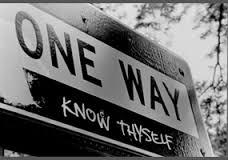 Ultimately, the most powerful tool for dealing with every day life is self knowledge. And there is no better way to access that repository of wisdom than through writing. Chances are you don���t need therapy, you don���t need a pill, you don���t need a bottle to make it though the day��� you need a purpose. Slow down, sit down and pick up the mantle of the warrior waiting inside of you. It is said: ���the pen is mightier than the sword:, that is true whether it be in dealing with interlopers from without or demons from within. Begin today, right now if possible. Don���t procrastinate. Just do it!
Ultimately, the most powerful tool for dealing with every day life is self knowledge. And there is no better way to access that repository of wisdom than through writing. Chances are you don���t need therapy, you don���t need a pill, you don���t need a bottle to make it though the day��� you need a purpose. Slow down, sit down and pick up the mantle of the warrior waiting inside of you. It is said: ���the pen is mightier than the sword:, that is true whether it be in dealing with interlopers from without or demons from within. Begin today, right now if possible. Don���t procrastinate. Just do it!
How to Begin
OK, we���ve covered why you should write, now it���s time to discover how. Where do you start? The most fundamental principle is to have a comfortable place and posture. By that I mean that especially when you���re starting out, it���s important to have good support for your body and quiet for your mind. A favorite chair or sofa that is firm, but not hard will reduce the fatigue associated with sitting in one position for an extended period. Pick a time every day or several times a week that works well with your schedule. Of course, responsibilities have to come first, but either before or after that, carve out time in your day for you.
I don���t like to use a pen or pencil. My writing is illegible and my hand gets tired. Fortunately, I learned how to type at an early age and adapted well to writing on the computer. You have to find what works for you. Ultimately, the computer is the preferred platform, because if you choose to send your works to someone, it���s as easy as a click. Additionally, you may choose to publish your writing on the web in the form of a blog like this one and having already saved your thoughts in a digital form makes that much easier. But the most important thing is just to start writing, regardless of the way you do it.
What to Write About
We discussed earlier how you life experiences can be mined for tantalizing stories, but maybe you���re one of the rare and fortunate individuals who is happy and well-adjusted. You are reconciled with your past, your present life is for the most part pleasurable and your future seems well in hand. Good for you! What contribution can you make? Chances are there is a secret to the settled life that you lead. Do you have a favorite hobby, do you volunteer for a special cause, are you able to travel? If so, where have you gone and what have you seen? If you say ���I have nothing to write about���, I say, you���re not using your imagination.
 Don���t worry too much about a structure at first. You need to develop the discipline of writing and your ���inner voice��� and that will just take time and practice. Allow the thoughts to be ���downloaded��� from your mind in a process we will call ���stream of consciousness���. Write several paragraphs and then read them over to better understand what you���ve written.
Don���t worry too much about a structure at first. You need to develop the discipline of writing and your ���inner voice��� and that will just take time and practice. Allow the thoughts to be ���downloaded��� from your mind in a process we will call ���stream of consciousness���. Write several paragraphs and then read them over to better understand what you���ve written.
It may seem odd, but writing and understanding are not the same. It is almost as if your subconscious dumps the raw emotions and ideas on to the paper or computer and then your analytical mind endeavors to make sense of them. Don���t worry too much about grammatical correctness or syntax, just try to ensure that the paragraphs link up somewhat, to develop a flow of ideas, rather than leaping from one subject to another. There will be time later to correct and refine the work into something you can be proud of.
Once you���ve decided what story you want to tell, try to identify several themes within that story that will form the various chapters. For an example: if you wished to tell people about your experiences volunteering in Africa, helping displaced families find food, water and housing, your list of chapters might read like this:
1. MY LIFE BEFORE AFRICA
2. THE DAY EVERYTHING CHANGED
3. THE HISTORY
4. THE PEOPLE
5. THE CRISIS
6. DOING THE IMPOSSIBLE
7. WHERE WE ARE TODAY
8. THE CHALLENGES GOING FORWARD
9. HOPE FOR THE FUTURE
10. MY LIFE AFTER AFRICA
This would make a great book! I���ll bet you���d like to read it now, based on the interesting chapter headings. This could be your book, but instead of Africa, maybe you���d discuss your challenges with overcoming a disease and the current state of research into a cure, etc. Or maybe your story would be about winning the lottery and how ironically, all that money solves some problems but creates many more. You catch my drift. The possibilities are limitless, as broad as the palette of human experience.
Turning your story into a book
 OK, hold on partner, you���re not ready for that quite yet. Don���t focus on the result, concentrate on finding your inner voice and refining it into a crystal clear message for yourself as well as your future readers. But you���ve set the goal of getting your story to a wide audience, through publishing a book.
OK, hold on partner, you���re not ready for that quite yet. Don���t focus on the result, concentrate on finding your inner voice and refining it into a crystal clear message for yourself as well as your future readers. But you���ve set the goal of getting your story to a wide audience, through publishing a book.
Now when people ask ���what do you do?��� you can truly say ���I am writing a book���.
It may take six months, it may take ten years, but you are on the path. Doesn���t it feel great? Stick with it and you will get there.
Happy writing!
-S.E. Mathias
My new book "The Happiness Tree" will be out this year, published by Balboa Press. Check back often for news of it's release and where you can buy it.
As always, feel free to send comments or questions to:
September 4, 2015
6 Stupid Things that Women Do To Screw Up Their Relationships
Ladies, this is not meant to vilify you or to suggest that men are never at fault for messing up their relationships, there is certainly plenty of blame on both sides of the fence. But this article for men will be upcoming. Today, we will focus on mistakes you might be making that could be causing your partnership to stagnate or worse, become irreparably damaged.
1. Don���t make men go shopping with you.
 Girls, I know that it feels nice when your man buys you something, but don���t drag him to the dress shop, for heaven���s sake. Men have a different relationship to shopping than you do. They buy when they need something, like a new tool, when the old one breaks. True, they do tend to spend lavishly on big ticket items, like cars and gadgets, but they generally do their research online first, or by asking their friends and associates. They don���t just go the the mall and peruse. For men there is nothing more boring than standing around looking at clothes. And when a man is bored, what does he do? He fantasizes about women. And what better place to do that then at a woman���s dress shop or the mall. That���s one reason this is not a good strategy.
Girls, I know that it feels nice when your man buys you something, but don���t drag him to the dress shop, for heaven���s sake. Men have a different relationship to shopping than you do. They buy when they need something, like a new tool, when the old one breaks. True, they do tend to spend lavishly on big ticket items, like cars and gadgets, but they generally do their research online first, or by asking their friends and associates. They don���t just go the the mall and peruse. For men there is nothing more boring than standing around looking at clothes. And when a man is bored, what does he do? He fantasizes about women. And what better place to do that then at a woman���s dress shop or the mall. That���s one reason this is not a good strategy.
____________________________________________________________
Check out the new website on Relationships: Men Decoded
__________________________________________________________
You may like clothes, purses, shoes and jewelry, but don���t cajole your man into buying them by dragging him to the store with you. You should have your own money and go shopping by yourself or with your girlfriends. If he wants to buy you something as a gift, that���s great, but he may choose to show his love and devotion in other ways, like building or fixing things, taking you on vacations, arranging a romantic candlelight dinner, etc.
As women complain about being valued only for their physical attributes, men feel many women see their wallet as an ATM machine. So if you want to be appreciated for your personality and actions as well as your body, extend the same balanced treatment to your man. Recognize him first and foremost for how he treats you, cares for and compliments you, rather than what he is able or willing to buy
2. Don���t try to change him into who you think he should be
 Women often go into a relationship with the notion that their man is a lump of clay and it is their responsibility to mold him into a need fulfilling machine. While it is true, many women do seem to develop a sense of themselves and where they���re going far earlier than men, yet a man���s journey of personal development still has to be largely self directed. When a woman usurps that task and mistakenly assumes she can then influence his development for her own benefit, she plays with fire. He may go along for a while, especially if he was emotionally damaged by the last relationship, but eventually, he���ll realize he���s being duped. The result may be that he���ll bolt and find someone else with whom to share all the valuable lessons you taught him.
Women often go into a relationship with the notion that their man is a lump of clay and it is their responsibility to mold him into a need fulfilling machine. While it is true, many women do seem to develop a sense of themselves and where they���re going far earlier than men, yet a man���s journey of personal development still has to be largely self directed. When a woman usurps that task and mistakenly assumes she can then influence his development for her own benefit, she plays with fire. He may go along for a while, especially if he was emotionally damaged by the last relationship, but eventually, he���ll realize he���s being duped. The result may be that he���ll bolt and find someone else with whom to share all the valuable lessons you taught him.
It���s better to find a man who already has qualities you admire and that are compatible with your own. Yes, it may take a while longer to find the right fit. but when you head down the slippery slope of tinkering with other people���s personalities, you may create a monster that one day will bite the hand that feeds him.
3. Don���t assume he can go toe to toe with you in the feelings department.
 I never understood how women expect men to be strong and sensitive, courageous and gentle, smart but not sarcastic, etc. OK, there are some exceptional men out there I guess who might fit that description, but how long do you plan to wait and do you really think they���re still single? Get real girl! Normal men usually fall squarely on one side of that line or the other. Either they are sweet and sensitive, but not particularly masculine or they are full of testosterone but not too well developed in the expression department. You have to choose what���s more important to you. Do you need a man to excite you and drive you wild in the bedroom or do you want one who will discuss philosophy all night, then wake up the next day and say ���let���s go shopping���? Really? That���s what your girlfriends are for. If you find a good man who works hard, is faithful, generous, smart and funny, you���ve done well.
I never understood how women expect men to be strong and sensitive, courageous and gentle, smart but not sarcastic, etc. OK, there are some exceptional men out there I guess who might fit that description, but how long do you plan to wait and do you really think they���re still single? Get real girl! Normal men usually fall squarely on one side of that line or the other. Either they are sweet and sensitive, but not particularly masculine or they are full of testosterone but not too well developed in the expression department. You have to choose what���s more important to you. Do you need a man to excite you and drive you wild in the bedroom or do you want one who will discuss philosophy all night, then wake up the next day and say ���let���s go shopping���? Really? That���s what your girlfriends are for. If you find a good man who works hard, is faithful, generous, smart and funny, you���ve done well.
Don���t emasculate him by expecting him to emote with you over your soap opera. You may end up with an androgynous bore who increasingly depends on you for affirmation and reassurance.
4. Don���t participate in arguing. Don���t remain in a relationship where compatibility continues to be an issue
 I once learned a very valuable lesson from a Siberian fur trader. He relied on 6-8 Huskies throughout the year for transportation, warmth, companionship, defense and so on. He was always training new dogs to replace the ones that would eventually be too old to provide their valuable services. Once in a while, a puppy would just display a stubbornness, a lack of ability to work with his peers or develop a functional relationship with his master. Instead of punishing the dog or forcing him to obey, his philosophy is ���just find another dog���. This is a useful tip in human relationships too. People generally do not change. Their personalities are pretty much fixed before their 18th birthday. If you and your partner cannot agree on simple things, if either of you feel the need to be defensive or competitive, it���s not a good match. In other words, he may be a strong dog, a beautiful dog, but if he cannot work with you, then he will just hold you back and make you miserable. Just find another dog.
I once learned a very valuable lesson from a Siberian fur trader. He relied on 6-8 Huskies throughout the year for transportation, warmth, companionship, defense and so on. He was always training new dogs to replace the ones that would eventually be too old to provide their valuable services. Once in a while, a puppy would just display a stubbornness, a lack of ability to work with his peers or develop a functional relationship with his master. Instead of punishing the dog or forcing him to obey, his philosophy is ���just find another dog���. This is a useful tip in human relationships too. People generally do not change. Their personalities are pretty much fixed before their 18th birthday. If you and your partner cannot agree on simple things, if either of you feel the need to be defensive or competitive, it���s not a good match. In other words, he may be a strong dog, a beautiful dog, but if he cannot work with you, then he will just hold you back and make you miserable. Just find another dog.
5. Move on from little hurts. Don���t keep dredging them up to use as ammunition against your partner
 Sorry ladies, but this is a characteristic feminine flaw, the inability to forget. Along the journey toward hopeful relationship bliss, there will be potholes, speed bumps and hazards, as each of you learn to navigate your own feelings and cope with each others��� differences. The result is that mistakes will be made on both sides. But where as men don���t reserve room in their brains to hang on to all that history, women do and they often replay it in technicolor in the context of an argument about something else. Men are more focused on the here and now, where as women see the relationship as a continuum, meaning that for them, what happened yesterday, last year or even a decade ago is just as relevant now as it was when it happened.
Sorry ladies, but this is a characteristic feminine flaw, the inability to forget. Along the journey toward hopeful relationship bliss, there will be potholes, speed bumps and hazards, as each of you learn to navigate your own feelings and cope with each others��� differences. The result is that mistakes will be made on both sides. But where as men don���t reserve room in their brains to hang on to all that history, women do and they often replay it in technicolor in the context of an argument about something else. Men are more focused on the here and now, where as women see the relationship as a continuum, meaning that for them, what happened yesterday, last year or even a decade ago is just as relevant now as it was when it happened.
Each time you place the spotlight on a past transgression, you rip open the wound and prevent it from healing, either for yourself or the relationship. Eventually, the timeline of the partnership is viewed only in the rearview mirror, punctuated by missteps and thoughtless acts or comments, rather than the quiescent and joyful spaces between them. You may feel it is useful to keep these moments of less than stellar behavior on the part of your man, visible, as a reminder to him to be more thoughtful about his actions. But he sees this as perpetual punishment and a prison of past mistakes from which he can never escape. Furthermore, since he cannot remember the details of these events nearly as well as you, he begins to doubt your retelling of the story. Each time they resurface, they appear to more sensational and to possess greater intensity. To him, this is akin to being retried over and over for the same crime and being found more guilty each time. This is a death nell for any relationship. To forget is a blessing. As each of you matures, so will your respective relationship to each other and these little hurts will begin to diminish in frequency. But if you refuse to let them fade into the past, as they should, the weight of collective guilt and injury will eventually snuff out any remaining passion and drive you farther apart.
Focus on what he does right and if he is faithful, caring, gentle and affectionate, count your blessings and let go of the little hurts along the way.
6. Don���t use sex as a way to control him.
 You may not like it, but sex is a very important part of a man���s life, at least through middle age. So, if he���s not getting it from you, he may seek it elsewhere. Don���t use sex like a carrot and stick, offering it as a reward when he does something you want and then withholding it when you���re upset. Also, don���t always wait for him to initiate. Especially if you���ve been hot and cold in the past, he may fear that he���ll be rejected again, so show him that you desire intimacy. Don���t be subtle. Men don���t read your cryptic signals, they need concrete messages that don���t require interpretation. Grab him where it counts and say ���Ooooh, I miss our time together���. That will get his attention for sure.
You may not like it, but sex is a very important part of a man���s life, at least through middle age. So, if he���s not getting it from you, he may seek it elsewhere. Don���t use sex like a carrot and stick, offering it as a reward when he does something you want and then withholding it when you���re upset. Also, don���t always wait for him to initiate. Especially if you���ve been hot and cold in the past, he may fear that he���ll be rejected again, so show him that you desire intimacy. Don���t be subtle. Men don���t read your cryptic signals, they need concrete messages that don���t require interpretation. Grab him where it counts and say ���Ooooh, I miss our time together���. That will get his attention for sure.
If you've enjoyed this article, please feel free to comment and or share it with your friends on social media.
You can also write me with questions about relationships at:
August 30, 2015
Discover Frida Kahlo and How She Turned Misery Into Mastery
 Most of us only know the Mexican painter Frida Kahlo from her provocative images and self portraits with their trademark ���unibrow���. But behind the paintings, which have become her most visible legacy, there is a grand story of tragedy and determination, love and loss, passion and romance which has sadly been obscured in the many decades since her passing.
Most of us only know the Mexican painter Frida Kahlo from her provocative images and self portraits with their trademark ���unibrow���. But behind the paintings, which have become her most visible legacy, there is a grand story of tragedy and determination, love and loss, passion and romance which has sadly been obscured in the many decades since her passing.
Let���s take a trip back to the time of the Mexican Revolution, to discover how the calamity that almost ended Frida���s life, ultimately came to define it.
Frida Kahlo was born Magdalena Carmen Frieda Kahlo y Calder��n on July 6, 1907 in a small town near Mexico City. Though she would travel to the United States on several occasions, her permanent residence was La Casa Azul (The Blue House), where she was born and would spend the majority of her life until her death in 1954.
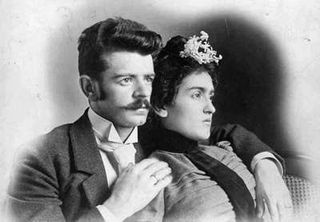 Kahlo's father, Guillermo Kahlo, (1871���1941), was born Carl Wilhelm Kahlo in 1871, in, Pfozheim, Germany, the son of Jakob Heinrich Kahlo and Henriette Kaufmann. Her mother Matilde Calder��n y Gonz��lez was a devoutly religious woman of Spanish and Indigenous heritage. Frida���s mother was often depressed or moody, leading to poor relations between them. But her father cared deeply for Frida and would come to have a strong influence on her life.
Kahlo's father, Guillermo Kahlo, (1871���1941), was born Carl Wilhelm Kahlo in 1871, in, Pfozheim, Germany, the son of Jakob Heinrich Kahlo and Henriette Kaufmann. Her mother Matilde Calder��n y Gonz��lez was a devoutly religious woman of Spanish and Indigenous heritage. Frida���s mother was often depressed or moody, leading to poor relations between them. But her father cared deeply for Frida and would come to have a strong influence on her life.
At age 6, Frida contracted polio, which caused her right leg to be thinner than her left, a disfigurement that she hid well behind long dresses. In an attempt to help Frida regain strength to her legs and make up for the time she spend convalescing from the disease, her father enrolled her in sporting activities that were more often than reserved for boys, such as swimming, bicycling, boxing and wrestling. Perhaps because of this, as she grew, she began taking on a very male appearance: dressing in men���s suits, styling her hair in a slicked back fashion. She would return to this androgynous look many times throughout her life, an appearance that was echoed by her periodic encounters with lesbianism.
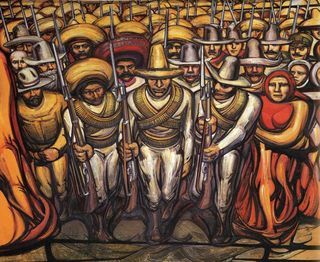 When Frida was 3 years old, Mexico���s revolution for independence from Spain began. Perhaps as many as a million people died during the revolution, many others were displaced, injured or just disappeared. And though it created tremendous upheaval for her family, Frida would later change the date of her birth to July 7th 1910, to coincide with the beginning of Mexico���s struggle for independence. Frida loved her country and came to believe that Mexico should follow Russia���s communist path. She aligned herself politically and philosophically with Marx and Stalin and even provided safe haven for Leon Trotsky during his exile from Russia.
When Frida was 3 years old, Mexico���s revolution for independence from Spain began. Perhaps as many as a million people died during the revolution, many others were displaced, injured or just disappeared. And though it created tremendous upheaval for her family, Frida would later change the date of her birth to July 7th 1910, to coincide with the beginning of Mexico���s struggle for independence. Frida loved her country and came to believe that Mexico should follow Russia���s communist path. She aligned herself politically and philosophically with Marx and Stalin and even provided safe haven for Leon Trotsky during his exile from Russia.
But the event that would most shape her life and eventually lead to her death was the terrible accident she suffered in 1925, at the age of 18. After a day of shopping and wandering around Mexico City with her boyfriend Alex Gomez Arias, She was riding in a wooden bus, which was struck in the side by a trolly.
I provide here an excellent description here from:
It was a gray day. A light rain had just fallen. After spending the afternoon wandering among the street stalls of downtown Mexico City , Frida and her boyfriend Alex G��mez Arias caught a bus that would take them home to Coyoac��n. The new bus was brightly painted with two benches along the sides. It was nearly full but Alex and Frida found seats together near the back. The bus driver sped off to cross the busy streets on his way out of town.
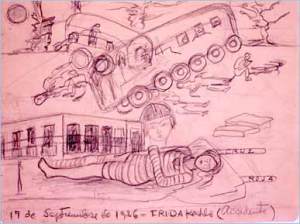 As the bus driver began to turn onto Calzada de Tlapan, a street trolley approached. The bus driver rashly tried to pass in front of the turning streetcar. He didn���t make it. Alex remembers the point of impact:
As the bus driver began to turn onto Calzada de Tlapan, a street trolley approached. The bus driver rashly tried to pass in front of the turning streetcar. He didn���t make it. Alex remembers the point of impact:
The electric train [streetcar] with two cars approached the bus slowly. It hit the bus in the middle. Slowly the train pushed the bus. The bus had a strange elasticity. It bent more and more, but for a time it did not break. It was a bus with long benches on either side. I remember that at one moment my knees touched the knees of the person sitting opposite me. I was sitting next to Frida. When the bus reached its maximal flexibility it burst into a thousand pieces, and the train kept moving. It ran over many people.
I remained under the train. Not Frida. But among the iron rods of the train, the handrail broke and went through Frida from one side to the other at the level of the pelvis.���
Frida said that the ���handrail pierced me the way a sword pierces a bull.��� Alex continues:
When I was able to stand up, I got out from under the train. I had no lesions, only contusions. Naturally the first thing that I did was to look for Frida.
Something strange had happened. Frida was totally nude. The collision had unfastened her clothes. Someone in the bus, probably a house painter, had been carrying a packet of powdered gold. This package broke, and the gold fell all over the bleeding body of Frida. When people saw her, they cried, ���La bailarina, la bailarina!��� With the gold on her red, bloody body, they thought she was a dancer.
I picked her up���.and then I noticed with horror that Frida had a piece of iron in her body. A man said, ���We have to take it out!��� He put his knee on Frida���s body and said, ���Let���s take it out.��� When he pulled it out, Frida screamed so loud that when the ambulance from the Red Cross arrived, her screaming was louder than the siren. Before the ambulance came, I picked up Frida and put her in the display window of a billiard room. I took off my coat and put it over her. I thought she was going to die. Two or three people did die at the scene���.others died later.���
It was during her 3 month confinement to bed that Frida���s father bought her implements with which to draw and paint. Frida eagerly adopted the activity and so began the development of one of Mexico���s most iconic folk artists.
The first piece she paints is called ���Self Portrait in a Velvet Dress��� - 1926
Notice that already, this earliest piece shows signs of her attention to detail. The collar of her dress displays stylistic shapes which might be derived from animal forms and or patterns. Behind her, an idealized sea roils, potentially threatening to consume her. The expression on her slightly turned face provides a clue to the somber, even dark mood which would dominate all the work in the years to come. Her arms, folded in front of her abdomen, demonstrate either intentionally or unwittingly a desire to protect the internal organs which were so badly injured only months earlier.
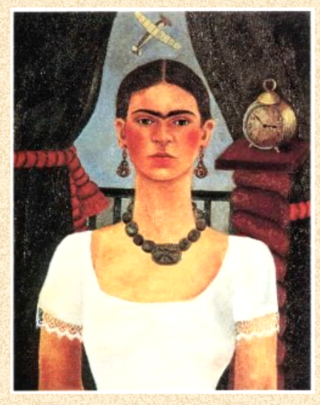 Her next work, called ��� Time Flies��� - 1929
Her next work, called ��� Time Flies��� - 1929
This work shows her much more open, facing forward and dropping her arms to the side to indicate confidence in her renewed health. Her neckline is open and her arms are bare. She is sporting a necklace and earrings, all suggesting she is ready to be vulnerable and feminine again. The black background could be interpreted as the unknown or the darkness she left behind, now that she was recovered from her months of convalescence. The use of symbolism is still present, but in a raw, immature form, immediately digestible by the observer without too much effort: the clock sitting on top of a stack of books to the right (time) and above her head, the image of an airplane (flies) to support visually the phrase which is embodied in the title.
This was also the year that Frida married Diego Rivera and as a result, further historical perspective is needed to understand the subtle nuances of this painting as contrasted to her earlier work. In ���Time Flies��� she is dressed in the more bright, traditional colors of her culture, the way that Diego preferred to see her, rather than the dark, melancholy and aristocratic attire shown in ���Self Portrait in a Velvet Dress���.
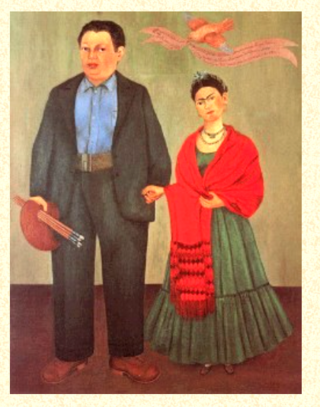 ���Frida and Diego Rivera��� - 1930
���Frida and Diego Rivera��� - 1930
This year Frida becomes pregnant, but has to abort due to a misalignment of the fetus, resulting from her fractured pelvis. Frida and Diego travel to San Francisco, California to fulfill some artistic commissions there. It was during this visit that this work becomes the first to receive a public viewing at the 6th Annual Exhibition of the San Francisco Society of Women Artists.
This painting, though loosely based on a wedding photograph, reveals much about the couple���s relationship: Diego appears huge next to Frida and though his 6 foot 1 inch frame overwhelms Frida���s petite 5 foot 3 inches, she exaggerates their disparate heights to ridiculous proportions here, but as always, there are symbolic reasons for doing so.
First of all, Frida not only looks up to Diego in the physical sense, but she also greatly admires his skill and perceives it to be far superior to her own. A sentiment further supported by the fact that in this representation he carries the tools of his trade, (brushes and a palette), while she appears unassuming, in a peasant dress almost as if lurking in his immense shadow.
Additionally, Frida���s parents did not approve of Diego, firstly because he was a committed communist, but additionally because of his girth. They referred to the couple as ���the elephant and the dove���. Yet, they eventually conceded to let the two marry as they believed Diego would earn sufficient income to cover Frida���s inevitable medical expenses.
Timeline of Frida���s Adult Life
Year
Event
1932
Frida���s second pregnancy ends in miscarriage
1934
Physiological problems cause Frida to abort her 3rd pregnancy. She also receives an emergency appendectomy. Later that year, she undergoes surgery to remove the ends of several toes on her right foot, presumably resulting from complications of the accident. Frida discovers that Diego is having an affair with her sister.
1936
Frida undergoes yet a 3rd operation on her right foot.
1937
Frida has her first showing of her work in Mexico, at Galeria de Arte at the National Autonomous University of Mexico
1938
In October, Frida travels to the Julien Levy Gallery in New York for her first solo showing of her work. Her pieces range in price from $150 to $600 and half of them are sold.
1939
Frida travels to Paris. Her painting ���The Frame��� becomes the first Mexican work of art purchased by the Lovre. She returns to Mexico and suffers a fungal infection on her hand and severe back pain. The pain forces her to begin drinking heavily. The doctor prescribes extended bed rest and traction on her neck. This same year, Frida and Diego file for divorce.
1940
Diego Rivera is sought for questioning in relation to the assassination of Leon Trotsky. Diego flees to San Francisco and due to her association with Diego, Frida is detained for 2 days and interrogated. Frida suffers from a severe kidney infection and anemia. Again she is prescribed extended bed rest. Later that year, Diego and Frida reconcile and re-marry.
1941
Frida���s father dies of an apparent heart attack and Frida goes into a deep depression which impacts her already ill health. Frida has two major exhibitions this year, in Mexico and in Boston.
1942
Frida sells her apartment and writes to government officials to support Diego in the construction of a museum to house his pre-Colombian artifacts.
1943
Frida enjoys many exhibitions, she begins teaching painting at a prestigious institution in Mexico City but is then prevented from traveling due to her poor health. She begins teaching out of her family home in Coyoacan.
1944
Frida undergoes extensive surgeries on her back and leg and is confined by several corsets and body casts. Her students complete a mural at the Hotel Posada del Sol but the owner is not satisfied and has it destroyed. Her work is exhibited in the U.S and Mexico city. She begins a diary which she will maintain until her death.
1945
After reading Freud���s ���Moses and Monotheism���, Frida paints ���Moses, her visual interpretation of the book.
1946
Frida receives a prestigious prize for her work ���Moses���. She undergoes a bone-graft operation and is confined to an iron lung for 8 months, during which time, her health deteriorates and she is put on high doses of morphine.
1947
Frida turns 40, but celebrates it as her 37th birthday, as she changed the date of her birth to coincide with the beginning of the Mexican Revolution.
1948
Diego Rivera begins an affair with Maria Felix and considers a divorce from Frida
1949
Frida���s sister pleas with Maria Felix to end the affair with Diego for the sake of Frida. In June, the affair abruptly ends. Gangrene becomes apparent on Frida���s right foot.
1950
Frida undergoes no less than 7 operations on her spine, mainly for infection in her bone grafts. Diego spends many nights in a room next to hers. When she is well enough, she paints.
1951
Following her discharge from the hospital, she spends the majority of the year in bed.
1952
Frida begins a series of still life paintings, perhaps in part because a portrayal of her actual pain and suffering would be too severe for the canvas and also, still life requires less detail then her self portrait, which she may have been unable to paint due to her heavy use of alcohol and pain killers.
1953
Frida had her first solo exhibition in Mexico, but doctors tell her she is too sick to leave her bed. She she has her bed carried to the exhibition and then returns home to a reunion of friends. Later this year, her leg is overcome with gangrene and has to be amputated below the knee.
1954
April 19th, Frida is admitted to the hospital for unknown reasons. She writes a three page letter to the doctors and nurses and everyone who ever took care of her to thank them for their kindness. In June, she contracts bronchial pneumonia and is confined to bed. Her health seems to improve. But on July 6th, against the advice of her doctors, she takes part in a political rally against American actions in Guatemala. Her health worsens and she is never seen in public again.
July 13, 1954
Seriously ill with pneumonia, Frida dies. The cause of death is determined to be pulmonary embolism. Her last written diary entry reads: ���I hope the exit is joyful - and I hope never to return��� - Frida
That afternoon her coffin is placed in the entrance hall of the Palacio de Bellas Artes, attended by an honor guard. On the 14th of July, more than 600 people came to pay their last respects. Her body was cremated later that day. Her ashes were placed in a pre-Columbian urn which is on display in the "Blue House" that she shared with Rivera.
What can we learn from Frida���s life and how she coped with adversity?
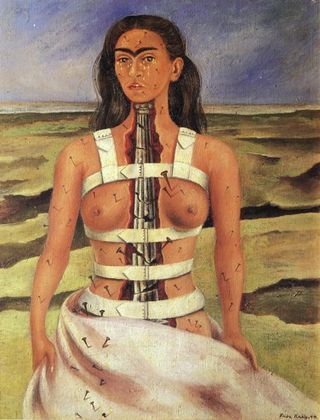 Frida���s life was punctuated by much physical pain and suffering. She was the victim of betrayals by her husband, Diego Rivera, as well as her sister and others. She spent many years alone and isolated in bed, enduring countless surgeries, protracted recoveries and the life-long effects of the horrible accident she suffered at 18.
Frida���s life was punctuated by much physical pain and suffering. She was the victim of betrayals by her husband, Diego Rivera, as well as her sister and others. She spent many years alone and isolated in bed, enduring countless surgeries, protracted recoveries and the life-long effects of the horrible accident she suffered at 18.
Additionally, in the early 20th Century, Mexican artists and in particular women were not recognized or celebrated. None of these seemingly insurmountable circumstances stopped Frida from creating her provocative images and providing us an intimate glimpse into her unique physical, cultural and spiritual challenges.
You may not like Frida���s paintings; you may not agree with her politics, or her promiscuous lifestyle; there are certainly many areas of Frida���s life in which one could find fault. But in spite of or perhaps because of the many tragedies in her life, she found the time, the inspiration and the energy to create enduring artwork that remains as a poignant reminder that vision, determination and a commitment to excellence ultimately defines who a person is, rather than what happens to them.
What dreams do you claim to not have time for, or are too tired to accomplish? What goals seem out of reach? What stops you from living life to the best of your ability, in spite of your circumstances?
What of your limitations exceed those of a petite girl, from a small village, nestled in the heart of an impoverished country, oppressed by rigid views of women���s roles, who suffered a life altering accident that would keep her in the hospital or bed-ridden most of her life?
The next time you say ���I can���t, think of Frida and the many other pioneers throughout history that could have said the same and yet, chose to never give up.
I would love to hear your thoughts on this or other articles "The Happiness Tree".
Please contact me: Shane Mathias
Also, please enjoy my other blog: Men Decoded
August 19, 2015
Truth Seeker vs Believer - Which is the More Righteous Path?
On general principles and to clarify the opinions that follow, it is never my intention to make you believe something, only to present the information and let you be the judge.
For regular readers of mine, this may seem like a contradiction, as I have stated in the past ���this is the truth���, about several things, a statement I now wish to amend, where ever it appears in my writing.
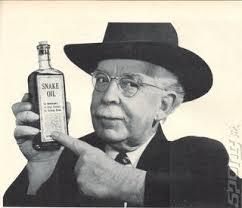 I say this now, because it occurs to me that way too much ���belief��� is being trotted out as ���the truth���, a practice which has throughout the ages, been used to deceive and control entire populations. Much of the ���New Age��� publishing network (to which I suppose I am unintentionally aspiring), gains it���s following by exploiting that fine line between truth and belief, ironically creating a community that defines itself as free thinking, but really is more cult-like in nature.
I say this now, because it occurs to me that way too much ���belief��� is being trotted out as ���the truth���, a practice which has throughout the ages, been used to deceive and control entire populations. Much of the ���New Age��� publishing network (to which I suppose I am unintentionally aspiring), gains it���s following by exploiting that fine line between truth and belief, ironically creating a community that defines itself as free thinking, but really is more cult-like in nature.
 It���s not hard to understand why. Belief is much easier. By believing, one can fall back on and be supported by a world view that others have created. Believers don���t have to ���reinvent the wheel���, they can tap into a matrix that has been accepted by thousands of others as ���the truth��� and feel secure that their path is the righteous one, as it is shared by so many ���like-minded��� individuals.
It���s not hard to understand why. Belief is much easier. By believing, one can fall back on and be supported by a world view that others have created. Believers don���t have to ���reinvent the wheel���, they can tap into a matrix that has been accepted by thousands of others as ���the truth��� and feel secure that their path is the righteous one, as it is shared by so many ���like-minded��� individuals.
Regardless of what happens in life, there is already a convenient explanation to provide solace for the believer. So comforting is this system of beliefs, it must be defended at all cost, because it forms the a protection that the believer uses to shield them from the pain of having to overturn all their preconceived notions and self deception, when life���s often confusing and frustrating situations present themselves.
 Belief also satisfies the often desperate need for community and camaraderie. By believing in a particular set of ideas, one who might otherwise feel self conscious and misunderstood, suddenly ���fits in���. The immediate availability of meetings, retreats, chatrooms, book clubs and other events serve to hold this disparate community together and reinforce the integrity of it���s belief-based infrastructure.
Belief also satisfies the often desperate need for community and camaraderie. By believing in a particular set of ideas, one who might otherwise feel self conscious and misunderstood, suddenly ���fits in���. The immediate availability of meetings, retreats, chatrooms, book clubs and other events serve to hold this disparate community together and reinforce the integrity of it���s belief-based infrastructure.
Truth-Seekers, on the other hand travel a much more solitary path. For this type of individual, belief takes on a completely different meaning. That being ���whatever conclusion his current level of understanding has led him to���. The Truth-Seeker embodies open-mindedness, as he or she is willing to allow their conclusions to be amended or even overturned if verifiable evidence indicates the necessity to do so. They are not attached to a particular mindset, but rather remain in constant pursuit of that illusive singularity: truth.
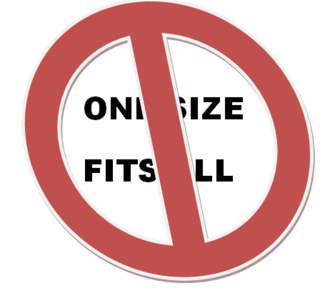 The Truth-Seekers constitution does not allow for a one-size-fits-all explanation of life���s conundrums. He believes in the power of his mind to dissect and then reassemble the elements of events and situation in his life to create clarity and thereby, provide answers. This indeed entails more work and uncertainty than the externally directed path of belief, but the truth-seeker values this process as an activity which builds character and deepens his understanding of himself and the world around him.
The Truth-Seekers constitution does not allow for a one-size-fits-all explanation of life���s conundrums. He believes in the power of his mind to dissect and then reassemble the elements of events and situation in his life to create clarity and thereby, provide answers. This indeed entails more work and uncertainty than the externally directed path of belief, but the truth-seeker values this process as an activity which builds character and deepens his understanding of himself and the world around him.
When one adopts an accepted point of view and ceases to evaluate those people and things that come into his life on their own merit, he stunts personal growth as well. He trades critical thinking for a virtual box that contains a predigested view of humanity, creation, the universe, even truth itself.
 History is replete with examples of how this reluctance to engage in a pragmatic evaluation of the facts, en masse, becomes the momentum behind some of man���s greatest inhumanity. Nazi Germany, the Crusades, Salem Witch Trials, the Spanish Inquisition and discrimination of all kinds are shocking examples of how the systematic promulgation of a distorted belief among groups of people binds weak-minded individuals together in a sort of blind rage against an entity they have come to see as the source of all their problems.
History is replete with examples of how this reluctance to engage in a pragmatic evaluation of the facts, en masse, becomes the momentum behind some of man���s greatest inhumanity. Nazi Germany, the Crusades, Salem Witch Trials, the Spanish Inquisition and discrimination of all kinds are shocking examples of how the systematic promulgation of a distorted belief among groups of people binds weak-minded individuals together in a sort of blind rage against an entity they have come to see as the source of all their problems.
How Does This Apply to Each of Us Individually?
When we change the focus of truth vs belief from a macro view to one that applies to your individual life experience, we can say with certainty, that knowing the truth doesn���t always lead to happiness, indeed, it may reveal unsettling realities about ourselves or relationships with others. But being denied access to that truth is a type of insidious evil that individuals, government and corporations use to control us and to promote their nefarious aspirations.
"knowing the truth doesn���t always lead to happiness"
 If in fact you desire to live in the light of clarity, you must make the pursuit of truth in all your affairs an ultimate priority. Additionally, if living with integrity is a value you hold dear, you must not deny friends or family access to the truth. To control others by withholding facts or engaging in deception is cruel and may ultimately result in self harm through the course of unanticipated consequences.
If in fact you desire to live in the light of clarity, you must make the pursuit of truth in all your affairs an ultimate priority. Additionally, if living with integrity is a value you hold dear, you must not deny friends or family access to the truth. To control others by withholding facts or engaging in deception is cruel and may ultimately result in self harm through the course of unanticipated consequences.
Truth seeking is characterized by self reliance and flexibility in thinking. One who seeks truth is aware that their view of self, others or the world around them is malleable and amenable to change. Believers on the other hand have a rigid view of their world and their place in it. They rely on an outside entity to create and define a system of beliefs that followers must adhere to. If someone or something does not jibe neatly with this credo, it is derided, disregarded or considered a threat their status quo.
I have chosen the path of truth. It would be my wish that you would consider the merits of that choice and investigate if perhaps this is the ���Rosetta Stone��� through which you will interpret the often cryptic clues to your true path, that await discovery all around you .
-Shane Mathias
If you have enjoyed the foregoing article, please feel free to share it with friends and family. You may find another venue for my writing at:
To send questions or comments, please contact me at:
August 12, 2015
A New Forum for Women to Learn About the Men in Their Lives
 Please visit my new site for women
Please visit my new site for women
The goal of this new exciting site is to enlighten women on the sometimes confusing behavior of men, what drives them, how they think, how to pick a good one and how to create and maintain a great relationship with them.
We will enjoy a no-holds-barred discussion that covers every topic from sex to finances, work to psychology. I look forward to receiving your questions and feedback.
I'll do my best to answer every question and respond to each comment.
Now there is a place for women to go to read real, honest, open and frank discussions about the issues that are important to them, related to the men in their lives. Join the conversation...
-Shane Mathias


